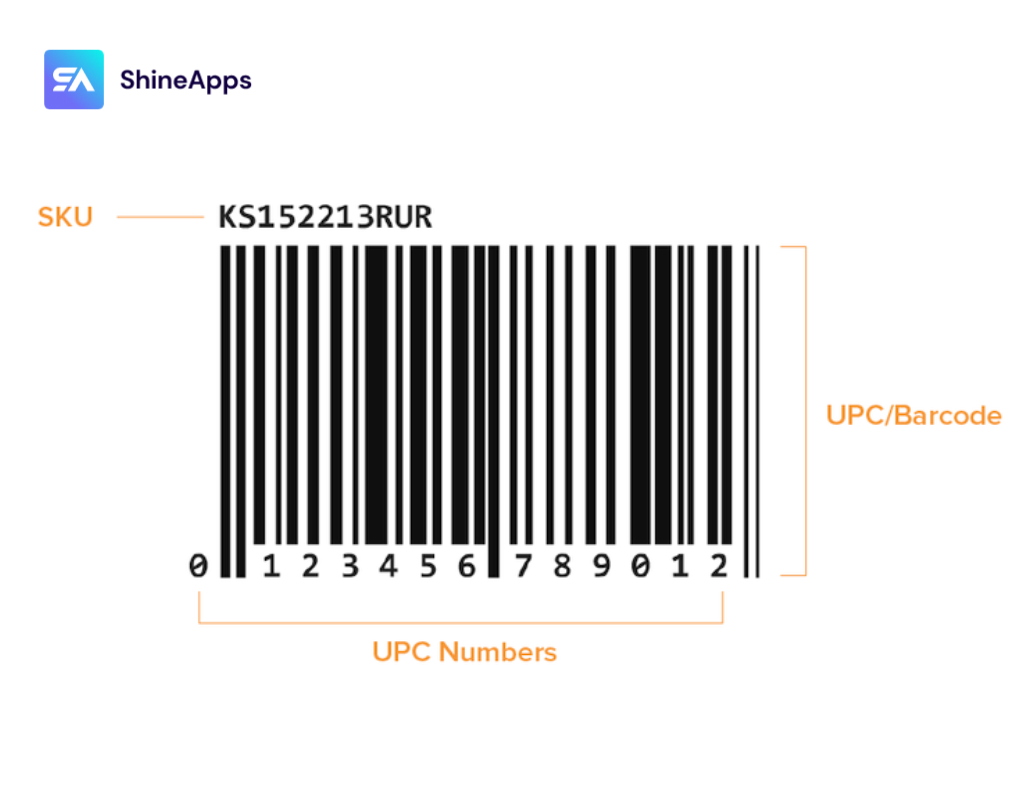In today’s dynamic marketplace, successful inventory management is crucial. A fundamental aspect of inventory management that is often overlooked is the SKU or Stock Keeping Unit. In this post, we’ll explore “What is a SKU?”, why it’s important, and how you can create effective SKUs to streamline operations and drive success for your business.
What is a SKU?

A SKU, or Stock Keeping Unit, is a unique code or identifier used in inventory management to track and manage individual products within a retailer’s inventory. SKUs are alphanumeric codes that can include a combination of letters, numbers, or special characters. They serve as a shorthand reference to distinguish one product from another, especially when dealing with multiple variants of the same product, such as different sizes, colors, or styles.
SKU vs Barcode vs UPC

Before diving into this, it’s important to clarify the difference among SKUs, barcodes, and UPC numbers.
Barcode: Barcode refers to the visual representation of data in the form of thin black bars that can be scanned by barcode scanners. They are used for digitally identifying products within a company’s inventory or for various other purposes.
UPC (Universal Product Code): UPC is a standardized 12-digit numerical code assigned to a product by the Global Standards Organization. It is used globally and remains the same regardless of where the product is sold. UPCs are primarily used for product identification in retail.
SKU (Stock Keeping Unit): SKU is an alphanumeric code that businesses can create and assign to each product variant in their inventory for internal tracking and identification purposes. SKUs are not standardized and can vary between different businesses or retailers.
Each of these identifiers serves a unique role in inventory management and product tracking within the retail industry. Barcodes are the visual representation, UPCs are standardized product identification codes, and SKUs are customizable codes for internal inventory tracking.
Why are SKUs important?

SKUs are important for several reasons in the world of retail and inventory management:
- Inventory Control: SKUs provide a systematic way to organize and categorize products in your inventory. By assigning a unique SKU to each product or product variant, you can easily track and manage stock levels. This prevents overstocking or understocking, helping you optimize your inventory and reduce carrying costs.
- Accurate Tracking: SKUs enable retailers to gather accurate data on the performance of individual products. You can track sales, returns, and other relevant metrics for each SKU, allowing for data-driven decision-making in terms of restocking, discontinuing products, or adjusting pricing strategies.
- Efficient Order Fulfillment: When it’s time to fulfill customer orders, SKUs streamline the process. Warehouse staff can quickly locate products based on their unique SKUs, reducing the likelihood of errors and ensuring that orders are shipped accurately and on time.
- E-commerce Optimization: For online retailers, SKUs are essential for organizing your product listings, optimizing search functionality, and ensuring a smooth shopping experience for customers.
- Product Variations: For retailers that offer products in multiple variations (such as different sizes, colors, or styles), SKUs are indispensable. Each variation can have its own SKU, making it simple to manage and differentiate similar products.
- Data analysis: SKUs provide detailed data that can be used for in-depth analysis. Retailers can determine which products are selling best and, which are underperforming, and make informed decisions about inventory levels, marketing strategies, and product promotions.
How to create SKU numbers?

Creating SKU numbers involves a systematic approach to assigning unique identifiers to each product or product variant in your inventory. Here are the steps to create SKU numbers:
Step 1: Select the SKU number format
Start by deciding on the SKU number format that aligns with your business objectives and requirements. Consider what details you want to include, such as product attributes (size, color, material), or any other pertinent identifiers. Typically, warehouse management teams employ various SKU code formats, including:
- Sequential numbers (e.g., 0001, 0002)
- Date-based numbers (e.g., YYMMDD)
- Hierarchical numbers (e.g., category-subcategory number)
Opt for a format that is clear, consistent, and adaptable to accommodate your future business expansion.
Step 2: Determine SKU Information

In alignment with your chosen format, decide on the specific details to incorporate into the SKU number. For instance, in the case of clothing, you may include size and color, while for electronics, you might consider brand, model, and specifications. Common elements of information encompass:
- Product category
- Brand
- Size
- Color
- Material
- Style
- Seasonality
Select pertinent and descriptive information that facilitates easy product retrieval and categorization within your business operations.
Step 3: Assign Unique Codes to Each Product
Create distinctive codes for every product, adhering to the selected format and information criteria. Prioritize ensuring absolute uniqueness, with no overlap among current or future codes.
Use serial numbers or a combination of alphanumeric characters to guarantee distinctiveness. Consider adopting a consistent pattern or logic that enables straightforward identification of product attributes or categories within the SKU numbers.
Step 4: Verify SKU Numbers
After generating SKU codes, conduct a thorough verification process to ensure accuracy and effectiveness. Confirm that the SKU numbers remain unique and that the included information is correct.
Test the system by applying these SKUs to actual products and within inventory management operations. This step is vital for identifying and resolving potential issues, allowing for refinements before implementing the SKU system throughout the entire warehouse.
Common Industries That Use SKUs

SKUs find applications across various industries. They facilitate better decision-making, enabling businesses to respond to market dynamics and customer demands more efficiently.
Brick-and-Mortar Retail
Physical retailers rely on SKUs to manage inventory levels and monitor sales at their brick-and-mortar stores. SKUs help them identify the best-selling products and determine when to restock inventory.
E-commerce
Online retailers apply SKUs to their websites, mirroring the inventory management practices of traditional retailers. SKUs empower e-commerce businesses to adjust pricing based on customer demand and swiftly reorder stock for key product categories.
Manufacturing
Manufacturers use SKUs to track materials and components, ensuring they maintain adequate inventory levels to complete current and future projects efficiently.
Wholesale
Wholesalers utilize SKUs for inventory tracking and sales analysis within their warehouses. This enables them to identify popular items and make necessary stock adjustments to meet buyer demand.
Logistics and Distribution
Logistics companies require real-time product tracking throughout the supply chain, from the point of origin to the final destination. SKUs play a crucial role in ensuring that products are delivered punctually and in the correct quantities.
Tips to create an SKU number system

- Simplicity is Key: While you can include many details, it’s advisable to focus on a few essential traits in your SKUs. Avoid overly long SKUs that are difficult to remember and interpret. Keep individual trait codes short and reflective of the trait.
- Start with the Most Important Variant: Prioritize your chosen traits and decide which one is most crucial to place at the beginning of your SKU codes. Starting with the most general identifier and working down to more specific traits is a recommended approach.
- Avoid Starting with a Zero: Computers often interpret a zero at the beginning of a SKU as nothing, leading to potential errors. To prevent this, avoid starting your SKUs with a zero and opt for a prominent trait that can be represented alphabetically.
- Minimize Letters That Resemble Numbers: To reduce confusion, limit the use of letters that closely resemble numbers in your SKU codes. For instance, avoid using the letter “O” (which can be mistaken for zero) and the letter “I” (which may be confused with one).
- Don’t use Manufacturer Numbers as SKUs: Avoid using exact manufacturer product codes for your SKUs, especially if you source inventory from multiple manufacturers. Developing your own SKU system provides better control and flexibility, allowing you to track the traits relevant to your business and streamline management.
To wrap up
In short, SKUs are a critical component of effective inventory management and e-commerce operations. By creating and using them wisely, you can enhance your ability to track products, manage inventory, and provide a seamless shopping experience for your customers. Implementing a well-structured SKU system can contribute significantly to the success and growth of your business.



